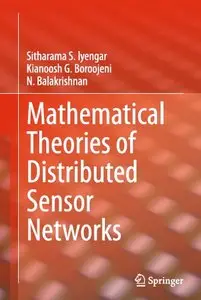Mathematical Theories of Distributed Sensor Networks By Sitharama S. Iyengar, Kianoosh G. Boroojeni
2014 | 172 Pages | ISBN: 1441984194 | PDF | 4 MB
2014 | 172 Pages | ISBN: 1441984194 | PDF | 4 MB
This book provides a Mathematical Theory of Distributed Sensor Networks. It introduces the Mathematical & Computational Structure by discussing what they are, their applications and how they differ from traditional systems. It also explains how mathematics are utilized to provide efficient techniques implementing effective coverage, deployment, transmission, data processing, signal processing, and data protection within distributed sensor networks. Finally, it discusses some important challenges facing mathematics to get more incite to the multidisciplinary area of distributed sensor networks. -This book will help design engineers to set up WSN-based applications providing better use of resources while optimizing processing costs. -This book is highly useful for graduate students starting their first steps in research to apprehend new approaches and understand the mathematics behind them and face promising challenges. -This book aims at presenting a formal framework allowing to show how mathematical theories can be used to provide distributed sensor modeling and to solve important problems such as coverage hole detection and repair. -This book aims at presenting the current state of the art in formal issues related to sensor networking. It can be used as a handbook for different classes at the graduate level and the undergraduate level. It is self contained and comprehensive, presenting a complete picture of the discipline of optical network engineering including modeling functions, controlling quality of service, allocation resources, monitoring traffic, protecting infrastructure, and conducting planning. This book addresses a large set of theoretical aspects. It is designed for specialists in ad hoc and wireless sensor networks and does not include discusses on very promising areas such as homotopy, computational geometry, and wavelet transforms.



